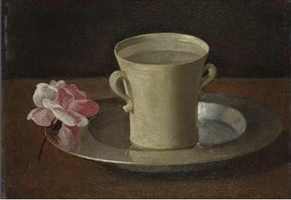Responses to a few images in this rich (and varied) exhibition.
I’m not a major fan of the Euston School but loved Passmore’s ‘The Red Tablecloth’. Sumptuous deep cadmium red cloth and brown-red space beyond, Vuillard-like – mystery and intimacy conjured in a spare and simple composition – nothing happening but much anticipated.
 Nature is always evident in a Sutherland. In his war commission paintings of wrecked buildings in the City of London, ‘The City: A Fallen Lift Shaft’,? a gangling structure like some embattled crustacean rearing up to the sky fighting to the end. And, ‘Devastation 1941: City’, Twisted Girders curl and writhe across the canvas as if in final death throes, a jagged toothed, gaping mouthed face of metal breathing its last lunges out at the viewer, speaking volumes.
Nature is always evident in a Sutherland. In his war commission paintings of wrecked buildings in the City of London, ‘The City: A Fallen Lift Shaft’,? a gangling structure like some embattled crustacean rearing up to the sky fighting to the end. And, ‘Devastation 1941: City’, Twisted Girders curl and writhe across the canvas as if in final death throes, a jagged toothed, gaping mouthed face of metal breathing its last lunges out at the viewer, speaking volumes.
Samuel Palmer, ‘A Cornfield by Moonlight with the Evening Star’, is by contrast a different sort of sublime. Deep moonlit shadows cast as a man walks through the corn grown high painted in a browns and rusts and catching a fleeting romantic moment of light and the richness of nature with man at peace within it.
Mary Kessell – delicate misty paintings of partially defined people in transition – uncertainty and fragility in her fragmented images of refugees.
A beautiful, intimate Henry Moore almost flat ironstone, ‘Head’, suggesting male one side and female the other and small enough to hold in the hand, to carry in the pocket like a rubbed stone.
 Zurbaran Still Life ‘ A Cup of Water and a Rose’ – painted in 1630 – timeless and perfect.
Zurbaran Still Life ‘ A Cup of Water and a Rose’ – painted in 1630 – timeless and perfect.
For insight into Kenneth Clark as art historian/collector try this article by James Hall in the Guardian
